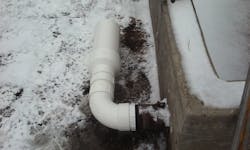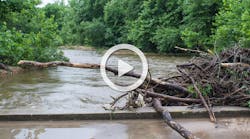Omitting Oil Sheen
Karen Hamel is a regulatory expert and trainer for HalenHardy. Hamel can be reached at [email protected].
undefinedIt has not stopped raining for three days. But even though the sun is not shining, a colorful oil sheen can still be unmistakably spotted; quietly sneaking toward a storm drain. Ignoring it could bring a notice of violation and pricey fines for violating the Clean Water Act.
Grabbing a spill kit is an option, but most absorbents do not work on oil sheens. Collecting the contaminated storm water and pumping it into a tank to be treated is another option, but sending all of that water out for processing is expensive.
Filtering oily sheen out of storm water is faster than trying to soak it up with absorbents. It is also far less expensive than sending water out for treatment. From the first moment an oil sheen appears until it reaches a storm water outflow, there are several opportunities to filter out the oil sheen and prevent costly fines.
Recognizing Sources of Oil Sheens
Although they may seem to appear out of nowhere, oil sheens can almost always be traced to specific locations. Identifying potential outdoor sources is the first step in determining how and where to filter oily sheens that could appear on-site.
One of the most prevalent sources of outdoor oil leaks and drips is oil-filled equipment. Sometimes, this equipment is stationary, such as industrial air compressors, pumps and transformers. They may only leak when they need maintenance, or they may have persistent drips that occur as a normal part of operation.
Portable oil-filled equipment includes vehicles, machinery, power generators and tools that require oil and/or fuel to operate. Like stationary equipment, it may also leak as part of its normal operation or due to age or need of maintenance. The source of these leaks may be a bit harder to determine if the equipment is routinely on the move, but storage areas are a good place to start looking, because if it leaks while it is not moving, chances are it also leaks when it is in service.
When mobile tanks and containers are in good condition and are simply being moved from one place to another, they do not tend to leak or drip. They are also not prone to spills unless someone runs into them or drops them. However, when they are used for mobile refilling, hoses, faucets or valves may leak.
Pipelines and hoses used to transport oil and fuel from holding tanks to processes, containers or equipment as well as valves and connections can leak when they are not properly maintained. Temperature extremes and the effects of natural disasters can also weaken them. Drops in pressure or flow rates can be indications of a leak somewhere in the system.
Another common source of outdoor oil leaks and drips are fueling stations, fluid dispensing and waste collection areas. The few drops from nozzles, faucets and pumps in these areas are common and are too often just left on the ground.
Filtering at the Source
For persistent leaks and drips from stationary sources, oil sheens can be filtered from rainwater at the source of the leak, before it even has a chance to hit the ground. Filtering oil sheens from rainwater is more effective than using drip pans that are easily overfilled and can become breeding grounds for mosquitoes, dragonflies and other waterborne insects.
While oil spill absorbents do not offer much more protection for persistent leaks than drip pans because when they become coated with rainwater, they allow oil sheens to float over their surfaces. They are quickly degraded by ultraviolet (UV) light, so they need to be replaced often.
Oil filter pans are newer to the market, and resolve the problems created by traditional drip pans and white oil spill absorbents. They stay in place like traditional drip pans and are not degraded by UV light. Instead of capturing both oil and water and holding it until drained, they contain UV-resistant sorbent media that filters oil drips and sheen out of rainwater, allowing the clean rainwater to drain from the pan.
Filtering on Paved Surfaces
Mobile equipment, vehicles and tools can make it difficult to trap and filter sheens at the source. When this is the case, there are still opportunities to filter the oil out of rainwater on paved surfaces before the sheen reaches a storm drain.
When it rains, oil sheens spread quickly and can cover large areas. Chemical dispersants can compound the problem by emulsifying the oil sheen, making it harder to separate from the water. White oil spill sheets float on water and get carried toward storm drains with the rainwater.
Filtering absorbent rugs stay where they are placed to quickly capture oil sheen. They can also be used to steer or channel oily sheen away from drains or other sensitive areas.
Filtering at Storm Drains
In addition to being prepared for oil sheens created from stationary and mobile sources, many facilities adopt the best practice of installing storm drain inserts to filter oil sheens and capture sediment. Drain inserts can be installed above or below the storm grate.
Along with standard operating procedures, preventive maintenance and other practices, storm drain inserts are a proactive step that facilities can take to filter oil sheens from storm water and minimize discharges. They will not, however, prevent large oil spills from escaping.
Filtering at Secondary Containment Outflows
Secondary containment systems that surround outdoor bulk storage tanks are sized to prevent even catastrophic spills from being released. In most states, there are even specific requirements for oversizing these systems to accommodate both a catastrophic spill and the water from a large storm event.
To prevent these systems from becoming filled with rainwater and snowmelt, facilities are required to check the systems regularly and drain any water that has accumulated. However, the discharged water must not contain oil or other pollutants when it is removed from the system.
Keeping secondary containment systems free of water between storms is difficult; especially at unmanned sites. It can also be time consuming to have an employee wait for all of the water to drain. These factors often lead to valves being left open, violating the terms of most permits and plans and increasing the risk of releasing water pollutants if the tanks or other items within the containment system fail.
By installing filter valves on secondary containment systems outflows, rainwater and snowmelt will passively drain from the system while pollutants are prevented from escaping. In the event of a spill from any of the tanks, containers or equipment stored in the system, the filtering media swells and closes the valve to prevent water pollutants from being discharged.
Filter valves not only save time, they can also save the expense of renting or hiring vacuum or pump trucks to remove water from the system. They are also far less costly than processing the collected storm water to remove trace amounts of oil.
Filtering at Storm Water Outflows
Sometimes it is not possible to capture an oil sheen before it reaches a storm drains. For drains that lead directly to streams, rivers or other receiving waters, filtering may still be an option at the discharge point or outflow.
Filtering rugs and booms can be placed in drain pipes and monitored regularly as a proactive measure. They may also be staged in vehicles or at outflow locations for fast response when an oil sheen is discovered.
Oil sheens spread very quickly when it rains. They can also head toward storm drains at paces of more than 5 feet per second. Incorporating filtering devices at potential sources of oil leaks and being prepared to quickly filter oil sheens from rainwater when the source is not stationary can prevent costly environmental violations as well as time spent chasing oil sheens all over the facility


